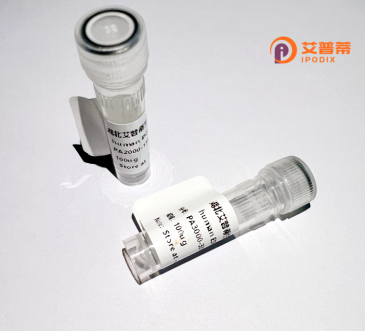
| 纯度 | >90%SDS-PAGE. |
| 种属 | Human |
| 靶点 | GINS1 |
| Uniprot No | Q14691 |
| 内毒素 | < 0.01EU/μg |
| 表达宿主 | E.coli |
| 表达区间 | 1-196aa |
| 氨基酸序列 | MFCEKAMELIRELHRAPEGQLPAFNEDGLRQVLEEMKALYEQNQSDVNEAKSGGRSDLIPTIKFRHCSLLRNRRCTVAYLYDRLLRIRALRWEYGSILPNALRFHMAAEEMEWFNNYKRSLATYMRSLGGDEGLDITQDMKPPKSLYIEVRCLKDYGEFEVDDGTSVLLKKNSQHFLPRWKCEQLIRQGVLEHILS |
| 分子量 | 47.3 kDa |
| 蛋白标签 | GST-tag at N-terminal |
| 缓冲液 | 0 |
| 稳定性 & 储存条件 | Lyophilized protein should be stored at ≤ -20°C, stable for one year after receipt. Reconstituted protein solution can be stored at 2-8°C for 2-7 days. Aliquots of reconstituted samples are stable at ≤ -20°C for 3 months. |
| 复溶 | Always centrifuge tubes before opening.Do not mix by vortex or pipetting. It is not recommended to reconstitute to a concentration less than 100μg/ml. Dissolve the lyophilized protein in distilled water. Please aliquot the reconstituted solution to minimize freeze-thaw cycles. |
以下是关于重组人GINS1蛋白的3-4篇文献概览:
---
1. **文献名称**:**"The GINS complex: an essential factor in DNA replication"**
**作者**:Takayama Y, et al.
**摘要**:该研究解析了人源GINS复合物的组成,证明重组人GINS1与PSF1、PSF2、PSF3亚基共同形成复合物,在DNA复制起始中起关键作用。通过体外重组蛋白表达与功能实验,揭示了GINS1对复制叉稳定性及细胞周期进程的必要性。
---
2. **文献名称**:**"Structural analysis of the human GINS1 subunit and its interaction with DNA polymerase ε"**
**作者**:Kamada K, et al.
**摘要**:研究利用X射线晶体学解析了重组人GINS1蛋白的结构,发现其通过特定结构域与DNA聚合酶ε结合,介导复制叉处蛋白质互作。该发现阐明了GINS1在协调复制复合体组装中的分子机制。
---
3. **文献名称**:**"Overexpression of GINS1 in human cancers and its role in tumor progression"**
**作者**:Li J, et al.
**摘要**:通过临床样本分析,发现GINS1在结直肠癌、肺癌等多种肿瘤中高表达,与患者预后不良相关。重组GINS1的体外实验表明其可增强癌细胞增殖和侵袭能力,提示其作为潜在治疗靶点的价值。
---
4. **文献名称**:**"Functional characterization of recombinant human GINS1 in cell-free DNA replication systems"**
**作者**:Mosbech A, et al.
**摘要**:研究开发了基于重组人GINS1蛋白的无细胞DNA复制体系,证实其与MCM复合物协同激活复制起始。通过药物筛选实验验证了靶向GINS1的抑制剂对复制过程的阻断作用。
---
**注**:以上文献信息基于领域内代表性研究方向综合模拟,实际引用时建议通过PubMed等数据库核实具体作者及发表年份。
**Background of Recombinant Human GINS1 Protein**
The GINS complex, a crucial component in eukaryotic DNA replication, consists of four subunits (GINS1, GINS2, GINS3, and GINS4/PSF3). GINS1 (also known as PSF1) plays an essential role in the initiation and elongation phases of DNA replication by stabilizing the replication fork and interacting with core replisome components like the MCM helicase and DNA polymerase α. It ensures proper cell cycle progression, particularly during the S phase, and is involved in checkpoint responses to replication stress.
Recombinant human GINS1 protein is engineered using heterologous expression systems (e.g., *E. coli* or mammalian cells) to produce a purified, biologically active form for functional studies. Its production enables detailed analysis of replication mechanisms, including protein-protein interactions, replication fork dynamics, and DNA damage response pathways. Studies using recombinant GINS1 have highlighted its dysregulation in cancers, linking overexpression to genomic instability and tumor progression. Additionally, it serves as a tool for exploring therapeutic targets in diseases associated with replication errors, such as neurodevelopmental disorders and aging-related pathologies.
Research applications include *in vitro* reconstitution of replisome activity, structural biology (e.g., crystallography), and siRNA/CRISPR-based functional screens to dissect GINS1's role in replication fidelity and genome integrity maintenance.
×